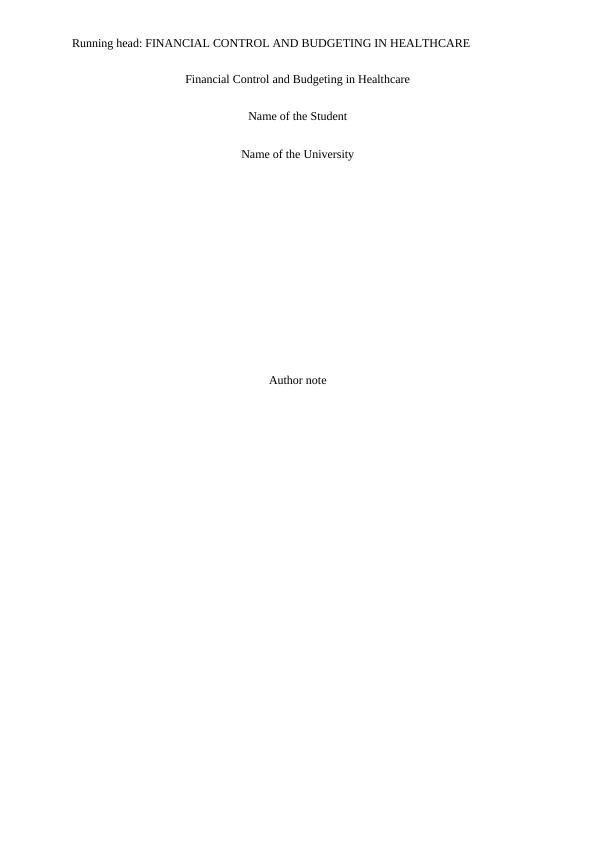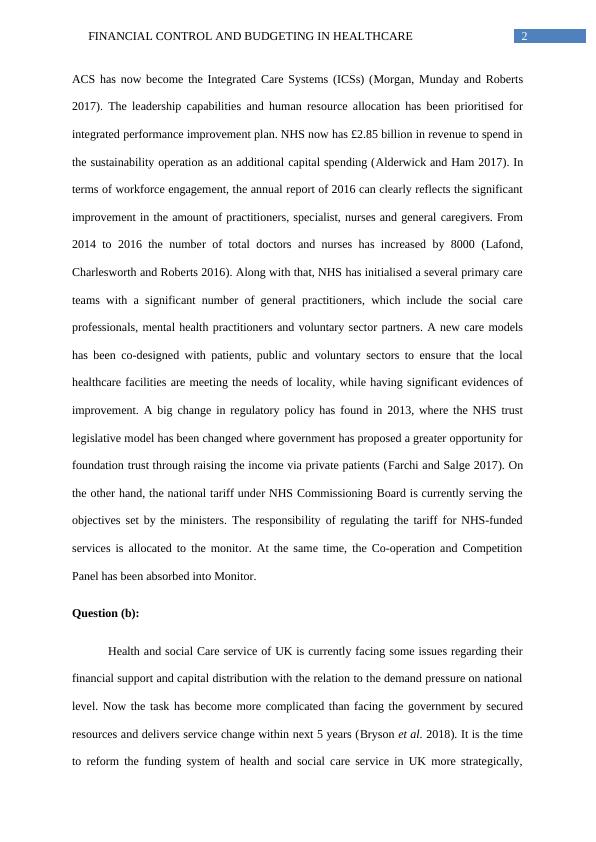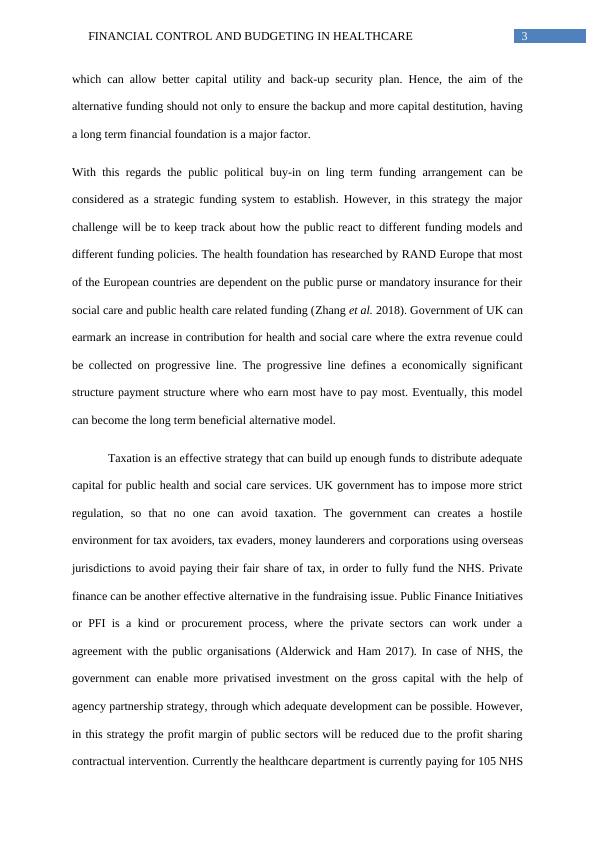Financial Control and Budgeting in Healthcare
Added on 2023-04-07
20 Pages4614 Words155 Views
Running head: FINANCIAL CONTROL AND BUDGETING IN HEALTHCARE
Financial Control and Budgeting in Healthcare
Name of the Student
Name of the University
Author note
Financial Control and Budgeting in Healthcare
Name of the Student
Name of the University
Author note

1FINANCIAL CONTROL AND BUDGETING IN HEALTHCARE
Task 1:
Question (a):
The budget on November 2017 consisted some valuable news of providing more
money to structural, operational and fundamental development (Dunn, McKenna and Murray
2017). With regards to these developmental concerns, there are some other factors that also
need sincere attention from both the national level authority as well as from the higher
management board of NHS. These significant factors are the legal, regulatory, social and
financial changes due to the new funding and changing macro environmental factors. The
budget provided an additional £1.6 billion for the NHS within the time span of 2018 to 19
(Robertson et al. 2017). In terms of operational development, NHS has declared that £600
million goes direct to the Clinical Commissioning Groups (CCGs) to stop repeating the
experience of holding the funding back. Additionally, the growth of CCGs has also
contributed to the overall share of fair funding. The reformation of 2011, has already
demanded significant financial changes in terms of funding allocation and payroll
development in workforce management (Dunn, McKenna and Murray 2017). The overall
performance of the provides has improved considerably by March 2018. The revision of
standardisation allowed NHS to set their new performance benchmark 7% above their
previous benchmark. Hence, after the revision of 2018 the providers are aiming to achieve
95% for the four hour A&R waiting times (Baylis and Powell 2018). This is the fundamental
fact of regulating the referral-to- treatment waiting time. As per the report of 2017, the
amount of people waiting more the 52 weeks is 1750 (Farchi and Salge 2017).
The situational analysis of the recent development of NHS can be examined through
their newly proposed system in order to uplift their ability to managing the procedural
distribution and operational efficiency as per the requirement. Accountable Care System or
Task 1:
Question (a):
The budget on November 2017 consisted some valuable news of providing more
money to structural, operational and fundamental development (Dunn, McKenna and Murray
2017). With regards to these developmental concerns, there are some other factors that also
need sincere attention from both the national level authority as well as from the higher
management board of NHS. These significant factors are the legal, regulatory, social and
financial changes due to the new funding and changing macro environmental factors. The
budget provided an additional £1.6 billion for the NHS within the time span of 2018 to 19
(Robertson et al. 2017). In terms of operational development, NHS has declared that £600
million goes direct to the Clinical Commissioning Groups (CCGs) to stop repeating the
experience of holding the funding back. Additionally, the growth of CCGs has also
contributed to the overall share of fair funding. The reformation of 2011, has already
demanded significant financial changes in terms of funding allocation and payroll
development in workforce management (Dunn, McKenna and Murray 2017). The overall
performance of the provides has improved considerably by March 2018. The revision of
standardisation allowed NHS to set their new performance benchmark 7% above their
previous benchmark. Hence, after the revision of 2018 the providers are aiming to achieve
95% for the four hour A&R waiting times (Baylis and Powell 2018). This is the fundamental
fact of regulating the referral-to- treatment waiting time. As per the report of 2017, the
amount of people waiting more the 52 weeks is 1750 (Farchi and Salge 2017).
The situational analysis of the recent development of NHS can be examined through
their newly proposed system in order to uplift their ability to managing the procedural
distribution and operational efficiency as per the requirement. Accountable Care System or

2FINANCIAL CONTROL AND BUDGETING IN HEALTHCARE
ACS has now become the Integrated Care Systems (ICSs) (Morgan, Munday and Roberts
2017). The leadership capabilities and human resource allocation has been prioritised for
integrated performance improvement plan. NHS now has £2.85 billion in revenue to spend in
the sustainability operation as an additional capital spending (Alderwick and Ham 2017). In
terms of workforce engagement, the annual report of 2016 can clearly reflects the significant
improvement in the amount of practitioners, specialist, nurses and general caregivers. From
2014 to 2016 the number of total doctors and nurses has increased by 8000 (Lafond,
Charlesworth and Roberts 2016). Along with that, NHS has initialised a several primary care
teams with a significant number of general practitioners, which include the social care
professionals, mental health practitioners and voluntary sector partners. A new care models
has been co-designed with patients, public and voluntary sectors to ensure that the local
healthcare facilities are meeting the needs of locality, while having significant evidences of
improvement. A big change in regulatory policy has found in 2013, where the NHS trust
legislative model has been changed where government has proposed a greater opportunity for
foundation trust through raising the income via private patients (Farchi and Salge 2017). On
the other hand, the national tariff under NHS Commissioning Board is currently serving the
objectives set by the ministers. The responsibility of regulating the tariff for NHS-funded
services is allocated to the monitor. At the same time, the Co-operation and Competition
Panel has been absorbed into Monitor.
Question (b):
Health and social Care service of UK is currently facing some issues regarding their
financial support and capital distribution with the relation to the demand pressure on national
level. Now the task has become more complicated than facing the government by secured
resources and delivers service change within next 5 years (Bryson et al. 2018). It is the time
to reform the funding system of health and social care service in UK more strategically,
ACS has now become the Integrated Care Systems (ICSs) (Morgan, Munday and Roberts
2017). The leadership capabilities and human resource allocation has been prioritised for
integrated performance improvement plan. NHS now has £2.85 billion in revenue to spend in
the sustainability operation as an additional capital spending (Alderwick and Ham 2017). In
terms of workforce engagement, the annual report of 2016 can clearly reflects the significant
improvement in the amount of practitioners, specialist, nurses and general caregivers. From
2014 to 2016 the number of total doctors and nurses has increased by 8000 (Lafond,
Charlesworth and Roberts 2016). Along with that, NHS has initialised a several primary care
teams with a significant number of general practitioners, which include the social care
professionals, mental health practitioners and voluntary sector partners. A new care models
has been co-designed with patients, public and voluntary sectors to ensure that the local
healthcare facilities are meeting the needs of locality, while having significant evidences of
improvement. A big change in regulatory policy has found in 2013, where the NHS trust
legislative model has been changed where government has proposed a greater opportunity for
foundation trust through raising the income via private patients (Farchi and Salge 2017). On
the other hand, the national tariff under NHS Commissioning Board is currently serving the
objectives set by the ministers. The responsibility of regulating the tariff for NHS-funded
services is allocated to the monitor. At the same time, the Co-operation and Competition
Panel has been absorbed into Monitor.
Question (b):
Health and social Care service of UK is currently facing some issues regarding their
financial support and capital distribution with the relation to the demand pressure on national
level. Now the task has become more complicated than facing the government by secured
resources and delivers service change within next 5 years (Bryson et al. 2018). It is the time
to reform the funding system of health and social care service in UK more strategically,

3FINANCIAL CONTROL AND BUDGETING IN HEALTHCARE
which can allow better capital utility and back-up security plan. Hence, the aim of the
alternative funding should not only to ensure the backup and more capital destitution, having
a long term financial foundation is a major factor.
With this regards the public political buy-in on ling term funding arrangement can be
considered as a strategic funding system to establish. However, in this strategy the major
challenge will be to keep track about how the public react to different funding models and
different funding policies. The health foundation has researched by RAND Europe that most
of the European countries are dependent on the public purse or mandatory insurance for their
social care and public health care related funding (Zhang et al. 2018). Government of UK can
earmark an increase in contribution for health and social care where the extra revenue could
be collected on progressive line. The progressive line defines a economically significant
structure payment structure where who earn most have to pay most. Eventually, this model
can become the long term beneficial alternative model.
Taxation is an effective strategy that can build up enough funds to distribute adequate
capital for public health and social care services. UK government has to impose more strict
regulation, so that no one can avoid taxation. The government can creates a hostile
environment for tax avoiders, tax evaders, money launderers and corporations using overseas
jurisdictions to avoid paying their fair share of tax, in order to fully fund the NHS. Private
finance can be another effective alternative in the fundraising issue. Public Finance Initiatives
or PFI is a kind or procurement process, where the private sectors can work under a
agreement with the public organisations (Alderwick and Ham 2017). In case of NHS, the
government can enable more privatised investment on the gross capital with the help of
agency partnership strategy, through which adequate development can be possible. However,
in this strategy the profit margin of public sectors will be reduced due to the profit sharing
contractual intervention. Currently the healthcare department is currently paying for 105 NHS
which can allow better capital utility and back-up security plan. Hence, the aim of the
alternative funding should not only to ensure the backup and more capital destitution, having
a long term financial foundation is a major factor.
With this regards the public political buy-in on ling term funding arrangement can be
considered as a strategic funding system to establish. However, in this strategy the major
challenge will be to keep track about how the public react to different funding models and
different funding policies. The health foundation has researched by RAND Europe that most
of the European countries are dependent on the public purse or mandatory insurance for their
social care and public health care related funding (Zhang et al. 2018). Government of UK can
earmark an increase in contribution for health and social care where the extra revenue could
be collected on progressive line. The progressive line defines a economically significant
structure payment structure where who earn most have to pay most. Eventually, this model
can become the long term beneficial alternative model.
Taxation is an effective strategy that can build up enough funds to distribute adequate
capital for public health and social care services. UK government has to impose more strict
regulation, so that no one can avoid taxation. The government can creates a hostile
environment for tax avoiders, tax evaders, money launderers and corporations using overseas
jurisdictions to avoid paying their fair share of tax, in order to fully fund the NHS. Private
finance can be another effective alternative in the fundraising issue. Public Finance Initiatives
or PFI is a kind or procurement process, where the private sectors can work under a
agreement with the public organisations (Alderwick and Ham 2017). In case of NHS, the
government can enable more privatised investment on the gross capital with the help of
agency partnership strategy, through which adequate development can be possible. However,
in this strategy the profit margin of public sectors will be reduced due to the profit sharing
contractual intervention. Currently the healthcare department is currently paying for 105 NHS

End of preview
Want to access all the pages? Upload your documents or become a member.
Related Documents
Improving Patient Care in Healthcare Organizationslg...
|16
|3329
|313
National Health a and Social Care Organisation Assignmentslg...
|7
|1915
|82
Audit and Expenditure Management in Healthcare Organizationslg...
|13
|5634
|85
Financial Control and Budgetinglg...
|16
|5371
|30
